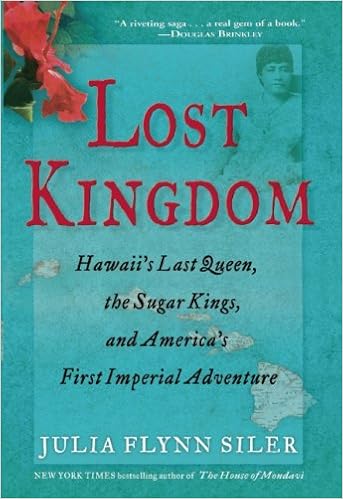
Lost Kingdom: Hawaii's Last Queen, the Sugar Kings, and America's First Imperial Venture
Paperback – January 8, 2013
Description
"Siler’s Lost Kingdom is a riveting saga about Big Sugar flexing its imperialist muscle in Hawaii . . . A real gem of a book." —Douglas Brinkley, author of Cronkite "A disturbing and dramatic story deftly captured by Julia Flynn Siler. She vividly depicts a cast of characters driven by greed, desperation, and miscalculation. How the queen lost her kingdom says as much about America and its new era of overseas expansion as it does about Hawaii." —T. J. Stiles, author of The First Tycoon: The Epic Life of Cornelius Vanderbilt , winner of the Pulitzer Prize and National Book Award"This imperial land grab in our not so distant past is far too little known . . . Julia Flynn Siler’s lively, moving, colorful account will help restore it to the place in our national memory where it ought to be." —Adam Hochschild, author of To End All Wars: A Story of Loyalty and Rebellion, 1914-1918 "[Siler is] able to color in many figures who had heretofore existed largely in outline or black and white . . . an important chapter in our national history, one that most Americans don’t know but should." — New York Times Book Review "Siler captures . . . what Hawaii was then and what it has evolved into today. What happened to the islands is known as one of the most aggressive takeovers of the Gilded Age . . . Siler gives us a riveting and intimate look at the rise and tragic fall of Hawaii's royal family . . . a reminder that Hawaii remains one of the most breathtaking places in the world. Even if the kingdom is lost." — Fortune "[A] well-researched, nicely contextualized history . . . ‘one of the most audacious land grabs of the Gilded Age.’" — Los Angeles Times "A fascinating . . . tale of intrigue and imperialism, supplemented throughout with anecdotes by and about literary luminaries such as Robert Louis Stevenson, Mark Twain, Herman Melville—all of whom traveled to and opined on the islands." — Christian Science Monitor "A well-told history of the U.S. acquisition of Hawaii . . . when Uncle Sam closed his grasp on the islands."— Seattle Times "A sweeping tale of tragedy, greed, betrayal, and imperialism . . . The depth of her research shines through the narrative, and the lush prose and quick pace make for engaging reading."— Library Journal (Starred review)"Too many Americans forget . . . our 'island paradise' was acquired via a cynical, imperious land grab . . . This is a well-written, fast-moving saga." — Booklist "Siler rehearses the dark imperial history of how Americans first arrived in the islands, how they rose in power and how they deposed the queen and took everything . . . A well-rendered narrative of paradise and imperialism." — Kirkus Reviews "Siler . . . skillfully weaves the tangled threads of this story into a satisfying tapestry about the late 19th-century death of a small nation [with] . . . sympathetic detail." — Publishers Weekly Julia Flynn Siler is an award-winning journalist. Her book, The House of Mondavi: The Rise and Fall of an American Wine Dynasty , was a New York Times best seller. She has written for Business Week and the New York Times , and is now a contributing writer for the Wall Street Journal in San Francisco.
Features & Highlights
- "Only one American state was formally a sovereign monarchy. In this compelling narrative, the award-winning journalist Julia Flynn Siler chronicles how this Pacific kingdom, creation of a proud Polynesian people, was encountered, annexed, and absorbed." —Kevin Starr, historian, University of Southern CaliforniaAround 200 A.D., intrepid Polynesians paddled thousands of miles across the Pacific and arrived at an undisturbed archipelago. For centuries, their descendants lived with almost no contact from the Western world but in 1778 their profound isolation was shattered with the arrival of Captain Cook. Deftly weaving together a memorable cast of characters,
- Lost Kingdom
- brings to life the ensuing clash between the vulnerable Polynesian people and the relentlessly expanding capitalist powers. Portraits of royalty, rogues, sugar barons, and missionaries combine into a sweeping tale of the Hawaiian kingdom’s rise and fall.At the center of the story is Lili‘uokalani, the last queen of Hawaii. Born in 1838, she lived through the nearly complete economic transformation of the islands. Lucrative sugar plantations owned almost exclusively by white planters, dubbed the "Sugar Kings," gradually subsumed the majority of the land. Hawaii became a prize in the contest between America, Britain, and France, each of whom were seeking to expand their military and commercial influence in the Pacific.
- Lost Kingdom
- is the tragic story of Lili‘uokalani’s family and their fortunes. The monarchy had become a figurehead, victim to manipulation from the wealthy sugar-plantation owners. Upon ascending to the throne, Lili‘uokalani was determined to enact a constitution reinstating the monarchy’s power but she was outmaneuvered and, in January 1893, U.S. Marines from the USS
- Boston
- marched through the streets of Honolulu to the palace. The annexation of Hawaii had begun, ushering in a new century of American imperialism.





